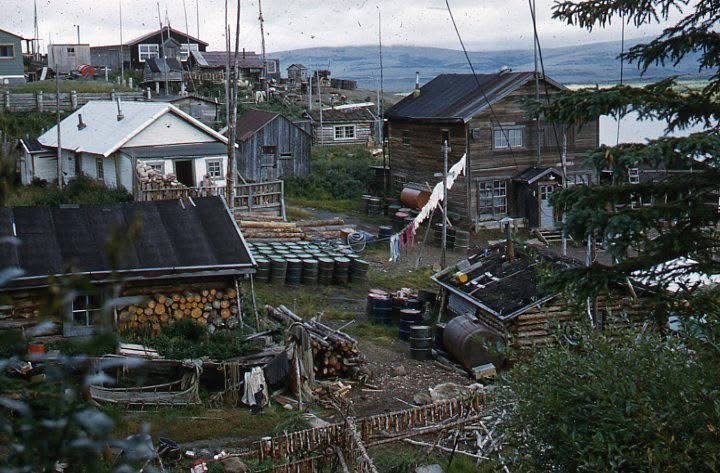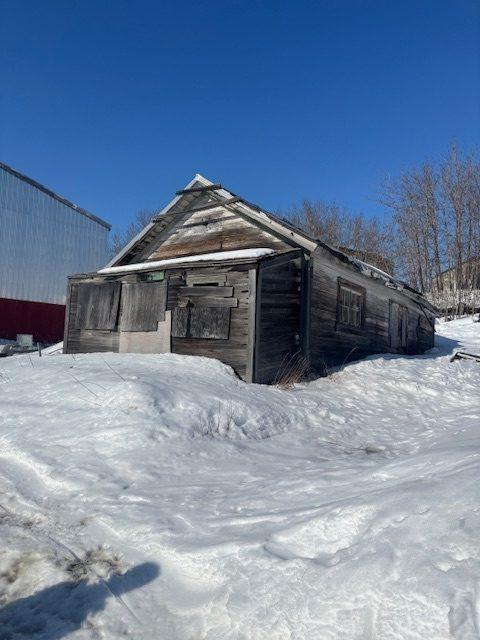
Pictured Kiana, previously called Squirrel City when gold miners came to Katyaaq. It later changed to Kiana.

Pictured Kiana, previously called Squirrel City when gold miners came to Katyaaq. It later changed to Kiana.
By Tessa Unaliin Baldwin
Spring 2025, FORUM Magazine
BELOW THE MOUNTAINS of the Northwest Arctic of Alaska lie three rivers forged together: the Squirrel River, IqmalitluNaq Channel, and the Kobuk River. Just above the bank of the Kobuk River lies Katyaaq, a historical Inuit community which translates to fork of the river. The scenery is breathtaking in any season, with large spruce trees and mountains that sprawl until the eye can no longer see. You would never know the unique history of Katyaaq unless someone told you directly. Yet, if you look closely, an old reminiscence of a bustling gold mining town exists today. A keen onlooker would see this history through a store that still exists today or tie this history to the last names of many families that still live in Katyaaq. A lot of our stories have not been told in written form, and even if they were written it is not often accessible to young people.
It is important to me to tell this story as it can often bring to light why things are the way they are. Why have Inupiaq people settled in this location? Why are there so few Inupiaq speakers today? What is the history behind the old school on the hill? What has added to the complexity of land claims in Alaska Native communities like Katyaaq? Why are the caribou changing migration patterns now? These are just a few questions that I have asked myself over the years that have led me to discover Alaska's Native history through my lineage.
Uvnga Unaliin. Qikiktagrukmiiangaluqtunga. kaŋiqaqtuŋa katyaaġmiuninlu ivisaappaagmiuninlu. Aŋayuqaaka sailaqlu ivganlu. In translation, my name is Unaliin. My English name is Teressa. I grew up in Kotzebue, Alaska, but my family roots come from up and down the Kobuk River. My mother is Sarah Randall from Ambler and my father is Clyde Baldwin Jr. from Kiana. My maternal grandparents are Regina Randall and Mike Linderman and the Late Ron Randall of Ambler. On my paternal side my grandparents are the late Eva and Clyde Baldwin Sr. of Noorvik and Kiana. Today I reside in Kiana.
I come from a long lineage of Inupiaq people who have forged and made our region home for thousands of years. My family can trace our lineage back to Maniilaq, an Inupiaq prophet who predicted the changes of life for Inupiaq people. Some people refer to his likeness as one of the last known shamans for Inupiaq people. However, because of the taboo nature of shamanism, it is not recorded outright that he was a shaman. During the time that Maniilaq was alive, Inupiaq people were migratory, often following the migration routes of caribou and fish. Maniilaq foresaw both the arrival of the first nalaagmii, white settlers, and the introduction of airplanes to the region. His prediction stated that once nalaagmii came to the region, Inupiaq people would no longer be migratory. For Katyaaqmii (people of Kiana), this prediction came true, but not until the turn of the 20th century, which was decades after the passing of Maniilaq.
It was in 1901 that three nalaagmii came in riverboats, making Kiana their permanent residence. A decade later, Katyaaq started growing with rumors that gold could be mined near Cleary Creek just outside of the young settlement. People traveled far distances to mine gold throughout the year, digging large pits in the frigid Arctic winter and storing the uncovered gravel until ice break. In the spring and summer time, gold miners would wash away the dirt with the intent of finding gold. My great-great-grandpa, Thomas Baldwin, moved to Kiana as a gold miner. He was born in 1874 in Massachusetts to two Irish Parents, George and Honora Baldwin, who immigrated due to the potato famine. When Thomas moved to Kiana, he married Kitik “Kitty” Sheldon, a native woman from the region who was born in 1880 near the banks of the Kobuk River. They settled in Kiana, making it their year-round home, just like many families whose history coincides with the gold mining days of Kiana.1 The last name, Baldwin, is still prominent in the Northwest Arctic Region, especially in Kiana, where its recent history stems from the gold mining days.

Thomas Baldwin’s house today nestled next to Blankenship, a local store that’s inception coincides with the gold mining history. Tessa Baldwin
During this time of gold mining, Native men often had jobs that were considered bottom-of-the-barrel jobs. The miners, in return, would give the Inupiaq men little cash for the work they did. Inupiaq men who received jobs bought flour, sugar, and other supplies that made life easier than what was known to the Inupiaq prior. This was a pivotal time in Inupiaq history as a cash economy was being introduced to Inupiat territories, altering the lifestyle of migratory people to integrate into a settlement. These changes happened quickly as more people, Inupiaq and Non-native people, started settling in Katyaaq. Due to the population growth associated with mining, Kiana became the first community to establish a school in the Northwest Arctic of Alaska.
During this time, even in the Arctic, Native peoples were seen as primitive men evidenced by the types of jobs they were given and that their children were not allowed to attend school, which included my great-grandpa Harry. The young village continued to grow, and in the 1940s was a record 170 people. A recording of an elder who lived during this time stated that the Inupiaq people used to live in old Kiana, and Nullagmii people lived in the present-day village, which shows further segregation during the time of settlement. Later on, all of Katyaaq moved to the present-day village due to erosion in the old settlement.
When I walk through Old Kiana or pass by the old school, I think about the stories left untold—about my taata and the childhood he lived that was shaped by this history. These stories helped me understand forgiveness and see my grandfather for who he was: a tall Inupiaq man who expressed his love through toughness.
It was not until my great-grandparents had their children that half-blooded Inupiat were allowed to attend school. My taata (grandpa), Clyde Baldwin Sr., was born during this time in 1939. He was one of the half-blooded children that was allowed to attend the school in Kiana because his grandpa was white. I only came about learning this story when I was in college and I was visiting with one of my taata’s suunaaq or in Inupaiq translates as good friends. He told me about the establishment of the school in Kiana. He stated, “When the school was built, they would make us (my grandpa and him) beat the other children for speaking Inupiaq.” He later went on to state that the other children were his cousins. During this time, you can find pictures of young native children, presumably half-blooded, with signs behind them saying “No Speaking Inupiaq.” Although this part of our recent history is recorded in manuscripts, it is often not talked about because we have elders in our communities who carry this burden of history today. It is an unspoken hurt centered around race that placed the Inupiaq family against other Inupiaq families with violence.
When I walk through Old Kiana or pass by the old school, I think about the stories left untold—about my taata and the childhood he lived that was shaped by this history. These stories helped me understand forgiveness and see my grandfather for who he was: a tall Inupiaq man who expressed his love through toughness. Today, the old school still stands quietly on a hill, hidden behind aging trees, with an unmarked and unfenced graveyard just off the beaten path—a silent reminder of the settlement in Katyaaq. My dad still pans for gold recreationally. The old store that opened during the gold mining days continues to operate. At Cleary Creek, remnants of old mining equipment sit waiting for a new day. This recent history deserves to be remembered and passed down. Katyaaq holds countless stories that have yet to be written, and it is through history that we begin to understand our surroundings and our people. I share this brief history of Kiana because much of it is not accessible to the young people who continue to call our region home. While some parts are captured in books or scattered manuscripts from earlier elders, these resources are difficult to access and often reflect the lens of outside observers. Our shared history speaks to experiences that many Alaska Native peoples know intimately—through settlement, integration, and the presence of churches, schools, and institutions that deeply altered Inupiaq life over the past century. Most villages in the Northwest Arctic were only settled as early as the 1950s, leaving much of this story still untold. For me, this part of history became a gateway to understanding the broader impacts of the past—and the resilience within it. ■
Tessa Unaliin Baldwin is from the Northwest Arctic. Her parents are Sarah Randall of Ambler and Clyde Baldwin Jr. of Kiana. Tessa currently resides in Kiana, Alaska where she is working for her tribal community. Tessa has her masters in social work from Columbia University and a bachelors from the University of California, San Diego. Tessa is a 2025 FORUM Writing Fellow.
FORUM is a publication of the Alaska Humanities Forum. FORUM aims to increase public understanding of and participation in the humanities. The views expressed by contributors are not necessarily those of the editorial staff or the Alaska Humanities Forum.
The Alaska Humanities Forum is a non-profit, non-partisan organization that designs and facilitates experiences to bridge distance and difference – programming that shares and preserves the stories of people and places across our vast state, and explores what it means to be Alaskan.
November 13, 2025 • MoHagani Magnetek & Polly Carr
November 12, 2025 • Becky Strub
November 10, 2025 • Jim LaBelle, Sr. & Amanda Dale